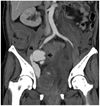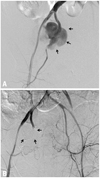Abstract
Spontaneous retroperitoneal hemorrhage is one of the most serious and often lethal complications of anticoagulation therapy. The clinical symptoms vary from femoral neuropathy to abdominal compartment syndrome or fatal hypovolemic shock. Of these symptoms, abdominal compartment syndrome is the most serious of all, because it leads to anuria, worsening of renal failure, a decrease in cardiac output, respiratory failure, and intestinal ischemia. We report a case of a spontaneous retroperitoneal hemorrhage in a 48-year-old female who had been receiving warfarin and aspirin for her artificial aortic valve. She presented with a sudden onset of lower abdominal pain, dizziness and a palpable abdominal mass after prolonged straining to defecate. Computed tomography demonstrated a huge retroperitoneal hematoma and active bleeding from the right internal iliac artery. After achieving successful bleeding control with transcatheter arterial embolization, surgical decompression of the hematoma was performed for management of the femoral neuropathy and the abdominal compartment syndrome. She recovered without any complications. We suggest that initial hemostasis by transcatheter arterial embolization followed by surgical decompression of hematoma is a safe, effective treatment method for a spontaneous retroperitoneal hemorrhage complicated with intractable pain, femoral neuropathy, or abdominal compartment syndrome.
A spontaneous retroperitoneal hemorrhage (SRH) is defined as a retroperitoneal hemorrhage that occurs without proceeding trauma or any underlying pathology.1 A SRH is an uncommon but well-known complication of anticoagulation therapy that causes significant morbidity and mortality.2-4 The treatment mainly consists of cessation or reversal of the anticoagulation, volume resuscitation, and transfusion when indicated. Surgery or radiologic intervention is performed if there is evidence of continued bleeding, but these two modalities have some disadvantages. The surgical management of a SRH is difficult with regards to both the identification and control of the bleeding site, and transcatheter arterial embolization (TAE) can not relieve a compressive manifestation such as femoral neuropathy (FN). This case suggests that TAE followed by surgical decompression is an effective and, safe method to treat a SRH complicated with FN or abdominal compartment syndrome (ACS) to prevent permanent nerve damage or a catastrophic event.
A 48-year-old woman presented with a sudden onset of lower abdominal pain, dizziness and a palpable abdominal mass after prolonged straining to defecate. She had been started on warfarin and aspirin after an artificial aortic valve replacement. The level of anticoagulation was stable. A large, tender lower abdominal mass was palpated on the physical examination. Her arterial blood pressure was 75/40 mmHg, and heart rate was 118 beat/min. The hemoglobin, hematocrit, and international normalized ratio (INR) were 4.6 g/dL, 14.6% and 4.25, respectively. Transfusion of 5 units of fresh frozen plasma and 4 units of packed red cells was followed by a fluid overload and 10 mg of vitamin K. An emergency CT scan demonstrated a large right-sided retroperitoneal hematoma that extended into the pelvis with active contrast extravasation (Fig. 1). In the view of active bleeding, an angiography was immediately performed to control the bleeding vessel. Active contrast extravasation was noted from the right proximal internal iliac artery and this bleeding focus was successfully embolized with a mixture of metallic coil, gelform and lipiodol. The subsequent angiography showed that the right internal iliac artery was completely occluded and any contrast leakage was no longer visible (Fig. 2).
However, the symptoms worsened during the next 8 hours. She developed severe pain in the right side of her groin and anterior thigh with associated paresthesia over the anterior thigh. She became anuric. The intra-abdominal pressure (IAP), as measured by the urinary bladder pressure, was 32 mmHg and the intra-abdominal perfusion pressure (IAPP) was 28 mmHg. Under the diagnosis of ACS and FN, she underwent an exploratory laparotomy. 4,000 mL of hematoma was removed and she immediately produced urine after the evacuation. Anticoagulation was restarted on the 2nd postoperative day. She was discharged in good condition on the 12th postoperative day.
A SRH is defined as bleeding without any known inciting trauma or underlying retroperitoneal pathology. A SRH is uncommon and is almost exclusively seen in association with anticoagulation states, coagulopathy, and hemodialysis.5,6 The exact mechanism is unknown, but several hypotheses have been suggested, including forceful muscular strain, diffuse small vessel arteriosclerosis, heparin-induced immune microangiopathy, and unrecognized minor trauma.7-9 As the indications for anticoagulation increase, the associated hemorrhagic complication will also likely increase.
The clinical presentation of SRH may show a wide range of symptoms from leg-hip pain or paresis to abdominal/flank/back pain or a catastrophic shock. One third of the patient with retroperitoneal hematoma have presented with severe pain, shock and a palpable mass, which is referred to as Lenk's triad, as with our case.10 Massive bleeding into the retroperitoneum represents a problem not only because of the loss of intravascular volume, but also because an increased IAP. The femoral nerve is subject to compressive neuropathy secondary to compartment syndrome because of its location. The two main mechanisms for developing FN are ischemia and pressure-related nerve damage.11 An abnormal, sudden increase in the volume of any component of the intra-peritoneal or retroperitoneal space can cause intra-abdominal hypertension. Measurement using a Foley catheter placed in the bladder has become the gold standard for determining the IAP.12 A sustained IAP > 20 mmHg and a IAPP < 60 mmHg that occur in association with new organ dysfunction or failure describes ACS.12 The manifestations of ACS, both systemic and clinical, are closely related to the consequences of intra-abdominal hypetension (IAH) at the organ level. Elevated IAP causes expansion of the abdominal cavity, which in turn results in cephalad displacement of the diaphragm, with a consequential reduction in dynamic pulmonary compliance and an increase in intra-thoracic pressure. The cycle consisting of impaired outflow, decreased capillary perfusion and increased pressure also results in decreased renal and hepatosplanchnic flow, inferior vena cava (IVC) compression, and decreased venous return with a consequential decrease in cardiac output.13 The mortality rate varies from 29% to 62%, and death is usually due to multiple organ failure and sepsis.14,15 To prevent end-organ failure and to decrease mortality, frequent IAP monitoring and timely surgical decompression are mandatory. Although there have been some reports about ACS combined with anticoagulation-related SRH,2,16,17 our current case is only the second reported case of ACS due to warfarin-related SRH.18
There are various types of approaches for the treatment of this relatively uncommon complication, such as conservative management, TAE, or surgical intervention. Conservative management for warfarin-related SRH consists of discontinuation of the drug, administration of vitamin-K and fresh frozen plasma, volume resuscitation and transfusion. Surgery or radiologic intervention should be performed, if the patient does not respond to supportive therapy. The surgical treatment of SRH is limited by the inability to localize or control the bleeding vessel and the risk of worsening the bleeding due to releasing the tamponade.19 When compared with surgical management, TAE is safe, fast and less invasive. The main drawback of TAE is that it cannot alleviate the mass effect of the hematoma. Ultrasound-guided decompression has been shown to alleviate neuropathy. Merrick, et al.20 reported that when even a small volume is aspirated, symptoms may improve. But when this procedure is done, there is the risk of a significant delay in definitive treatment.
With regards to our current case, a nonoperative approach to the retroperitoneal bleeding was first attempted. However, after successful bleeding control by TAE, the patient's general status deteriorated and she presented a clinical picture of ACS, which led to a straightforward decision to perform a laparotomy. The result of this case suggests that a sequential approach, that is, TAE followed by surgical decompression, is a safe, effective method to treat SRH complicated with femoral neuropathy or ACS.
Figures and Tables
References
2. Chan-Tack KM. Fatal spontaneous retroperitoneal hematoma secondary to enoxaparin. South Med J. 2003. 96:58–60.

3. Curry PV, Bacon PA. Retroperitoneal haemorrhage and neuropathy complicating anticoagulant therapy. Postgrad Med J. 1974. 50:37–40.

4. Hodin E, Dass T. Spontaneous retroperitoneal hemorrhage complicating anticoagulant therapy. Ann Surg. 1969. 170:848–851.

5. Bhasin HK, Dana CL. Spontaneous retroperitoneal hemorrhage in chronically hemodialyzed patients. Nephron. 1978. 22:322–327.

6. Fernandez-Palazzi F, Hernandez SR, De Bosch NB, De Saez AR. Hematomas within the iliopsoas muscles in hemophilic patients: the Latin American experience. Clin Orthop Relat Res. 1996. (328):19–24.
7. Heim M, Horoszowski H, Seligsohn U, Martinowitz U, Strauss S. Ilio-psoas hematoma--its detection, and treatment with special reference to hemophilia. Arch Orthop Trauma Surg. 1982. 99:195–197.

8. Torres GM, Cernigliaro JG, Abbitt PL, Mergo PJ, Hellein VF, Fernandez S, et al. Iliopsoas compartment: normal anatomy and pathologic processes. Radiographics. 1995. 15:1285–1297.

9. McCort JJ. Intraperitoneal and retroperitoneal hemorrhage. Radiol Clin North Am. 1976. 14:391–405.
10. González C, Penado S, Llata L, Valero C, Riancho JA. The clinical spectrum of retroperitoneal hematoma in anticoagulated patients. Medicine (Baltimore). 2003. 82:257–262.

11. Sasson Z, Mangat I, Peckham KA. Spontaneous iliopsoas hematoma in patients with unstable coronary syndromes receiving intravenous heparin in therapeutic doses. Can J Cardiol. 1996. 12:490–494.
13. McNelis J, Marini CP, Simms HH. Abdominal compartment syndrome: clinical manifestations and predictive factors. Curr Opin Crit Care. 2003. 9:133–136.

14. Hunter JD, Damani Z. Intra-abdominal hypertension and the abdominal compartment syndrome. Anaesthesia. 2004. 59:899–907.

15. Moore AF, Hargest R, Martin M, Delicata RJ. Intra-abdominal hypertension and the abdominal compartment syndrome. Br J Surg. 2004. 91:1102–1110.

16. Dabney A, Bastani B. Enoxaparin-associated severe retroperitoneal bleeding and abdominal compartment syndrome: a report of two cases. Intensive Care Med. 2001. 27:1954–1957.

17. Vayá A, Mira Y, Aznar J, Todolí J, Arguedas J, Solá E. Enoxaparin-related fatal spontaneous retroperitoneal hematoma in the elderly. Thromb Res. 2003. 110:69–71.

18. Andrade MM, Pimenta MB, Belezia Bde F, Xavier RL, Neiva AM. Abdominal compartment syndrome due to warfarin-related retroperitoneal hematoma. Clinics (Sao Paulo). 2007. 62:781–784.

19. Dondelinger RF, Trotteur G, Ghaye B, Szapiro D. Traumatic injuries: radiological hemostatic intervention at admission. Eur Radiol. 2002. 12:979–993.

20. Merrick HW, Zeiss J, Woldenberg LS. Percutaneous decompression for femoral neuropathy secondary to heparin-induced retroperitoneal hematoma: case report and review of the literature. Am Surg. 1991. 57:706–711.




 PDF
PDF ePub
ePub Citation
Citation Print
Print




 XML Download
XML Download